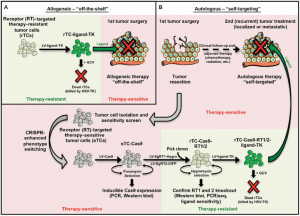Two abilities of the cancerous cells are self-seeding and self-homing. Former allows them to spread to other parts of the body with circulation and grow new tumors and by latter, they can move around the body to locate and return to the tumors. It also has been discovered that certain proteins like TRAIL can trigger pathways that induce programmed-cell-death (apoptosis) in many types of cancerous cells with no side effect on the healthy cells. Methods have been developed to modify cancerous cells and enable them to secrete these proteins and so using these engineered cells for the drug delivery and treatment of cancer. Two issues along the way of clinical implementation of this idea are the pre-mature self-toxicity of the cells and growth of a new tumor by the division of these engineered cells.
To bring this idea closer to clinical use, researchers at Harvard University proposed an autologous approach that begins by resection of the tumor of the patient. Next, they used CRISPR technology to modify treatment-sensitive cells and make them resistant against TRAIL-induced apoptosis. This step is followed by two other modifications of enabling cells to secrete TRAIL and modifying the immunosystem of the cells to sensitize them to a secondary therapy with no harm for the healthy cells. These engineered cells are ready for injection to the blood vessels of the patient and they may return to the tumors due to rehoming ability. Inside the tumor, they can act as treatment agents and release TRAIL while a secondary treatment is available to kill these modified cancerous cells once required.
This approach was tested on the rats with metastatic cancer. Reduction of the volume of the tumors and prolonging the lifespan of the animals in comparison with a control group that did not receive the therapy was observed.
 Figure 1 – (B) is the process of the proposed autologous approach for the treatment of cancer. Resection of tumor and removal of cancerous cells is followed by a screening step to keep the receptor targeted RT therapy sensitive cells for CRISPR enhancement of the phenotype to make them therapy-resistant is performed.
Figure 1 – (B) is the process of the proposed autologous approach for the treatment of cancer. Resection of tumor and removal of cancerous cells is followed by a screening step to keep the receptor targeted RT therapy sensitive cells for CRISPR enhancement of the phenotype to make them therapy-resistant is performed.
Reference:
Reinshagen, Clemens, et al. “CRISPR-enhanced engineering of therapy-sensitive cancer cells for self-targeting of primary and metastatic tumors.” Science translational medicine 10.449 (2018): eaao3240.